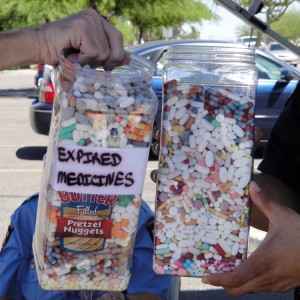Federal Water Tap, September 15: DEA Publishes New Rules for Handling Sensitive Prescription Drugs
The U.S. Drug Enforcement Administration made final new rules that will help prevent unused medications from contaminating waterways. Pharmacies are now authorized to collect unwanted narcotics, stimulants, and other “controlled substances.” Before, these pills had to be turned over to law enforcement officials.
One-day drug collection events have grown in popularity. Clean water advocates are hopeful that the new rules spur many more people to clean out their medicine cabinets.
One casualty of the new rule is the DEA’s sponsorship of twice-yearly drug collections. The final federal “take-back” event is September 27.
Pesticides in U.S. Rivers
Pesticides are found in U.S. rivers at concentrations above health standards for aquatic life at roughly the same frequency as two decades ago, according to a U.S. Geological Survey study comparing 10-year trends. Benchmarks for human health, however, are exceeded less frequently, the study shows.
The study reveals a pesticide landscape altered by regulatory restrictions and a changing menu of chemical options for farmers and domestic lawn-lovers.
“New pesticides come into use and others decrease,” Wesley Stone, the study’s lead author, told Circle of Blue. “It’s a constant effort to prioritize the pesticides. The resources don’t exist to analyze all of them.”
The study analyzed 123 pesticides for the years 2002 to 2011, three times as many as were analyzed from 1992 to 2001 but less than half the more than 400 bug-killers commonly used in the United States.
The study did not assess the toxicity of the pesticides to fish and frogs. It measured the occurrence of pesticides in rivers and not their effect, an important distinction, Stone said.
Water Research Centers
The U.S. Environmental Protection Agency will give $US 8 million in grant funding for two water research centers. Splitting the money evenly over three years, both centers will focus on issues affecting small water supply systems, those serving fewer than 10,000 people.
The WINSSS center, housed at the University of Massachusetts, Amherst, will emphasize water treatment technologies, whereas the DeRISK center, at the University of Colorado, Boulder, will look at the harmful compounds occasionally produced after chlorinating water.
Outstanding Debt for Federal Irrigation Projects
Over the last century, the federal government spent $US 20 billion to build canals, pipelines, and reservoirs to carry water to farm fields. Of the total, irrigation districts, the organizations that have contracts for the water, are supposed to contribute $US 6.4 billion. According to an analysis by the government’s internal watchdog, a quarter of the repayment cost – some $US 1.6 billion – is still to be paid.
The Government Accountability Office (GAO) recommends that repayment information, which the Interior Department publishes annually but rarely flaunts, should be made more visible to the public. The Interior Department agreed.
Missouri River Flood Response
A panel of public and private sector experts convened by the GAO concluded that the U.S. Army Corps of Engineers took appropriate steps to handle a record flood on the Missouri River in the spring of 2011. The corps, which manages large dams on the river, blew up a dike in Missouri to relieve pressure on the river engorged by rain and snow melt.
The panel recommended that the corps consider new flood forecasting methods. The Defense Department agreed.
Not Transparent
The EPA is withholding information from the agency’s watchdog, which hinders the investigation of misdeeds, according to congressional testimony by Arthur Elkins, the EPA inspector general. Elkins testified before the House Committee on Oversight and Government Reform.
Elkins and 46 other federal inspectors general sent a letter to committee leaders sounding their concern about the Obama administration’s persistent denial of access to agency employees and records.
Groundwater Revision
The head of the U.S. Forest Service said that the proposed guidance for considering groundwater in policies that affect national forest land is poorly written.
“Definitely, we need to make some changes to the proposed directive to really clarify what the intent is and what it is not. There are a lot of questions and concerns when it comes to water rights,” Tom Tidwell told the Associated Press.
State and local officials in the western United States are concerned that the federal directive steps on their toes. Except in certain cases involving endangered species, the federal government does not have a direct role in groundwater management.
Water Rights Settlement
A House Natural Resources subcommittee will discuss on Friday a water rights settlement for Arizona’s Bill Williams River that was introduced in Congress earlier this year.
Obama Climate Plan Hearing
The House Science Committee thinks the Obama administration’s climate change plan is poorly designed. The committee members will chat with Obama science advisor John Holdren on Wednesday about their misgivings.
Federal Water Tap is a weekly digest spotting trends in U.S. government water policy. To get more water news, follow Circle of Blue on Twitter and sign up for our newsletter.
Brett writes about agriculture, energy, infrastructure, and the politics and economics of water in the United States. He also writes the Federal Water Tap, Circle of Blue’s weekly digest of U.S. government water news. He is the winner of two Society of Environmental Journalists reporting awards, one of the top honors in American environmental journalism: first place for explanatory reporting for a series on septic system pollution in the United States(2016) and third place for beat reporting in a small market (2014). He received the Sierra Club’s Distinguished Service Award in 2018. Brett lives in Seattle, where he hikes the mountains and bakes pies. Contact Brett Walton






Leave a Reply
Want to join the discussion?Feel free to contribute!